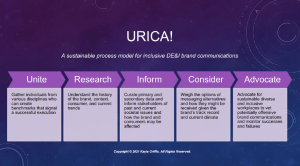In the field of marketing and communications, integrating diversity, equity, and inclusion (DE&I) is extremely important. Recognizing this, TAI alumna, Kayla Griffis, a senior strategist at Saatchi & Saatchi, and Dr. Alice Kendrick, Professor of Advertising at Temerlin, worked together to publish a new content creation model that emphasizes the importance of inclusivity. Dr. Kendrick was honored to present the URICA! Model in Oxford, England last summer at the Oxford Roundtable Symposium.

Published in the Forum on Public Policy, this study titled, Integrating DE&I into content creation: The URICA! Model, stands out as a versatile tool for embedding DE&I principles into the fabric of academic and corporate environments. The URICA! Model was originally pioneered by Kayla Griffis as a graduate student project for an advertising class led by Dr. Kendrick. It initially focused on addressing the insensitive spread of digital blackface on social media. This project evolved into a robust model designed to guide content creators through a comprehensive process to help team members determine DE&I objectives and avoid marketing missteps based on a lack of cultural sensitivity.
The core of the URICA! Model involves a series of sequential steps and considerations that assist creators in ensuring their messaging is inclusive and sensitive to diverse audiences. It encourages a thorough understanding of cultural nuances, informs strategic decisions with solid DE&I foundations, and carefully considers the potential impacts of messaging. The model’s flexibility makes it suitable for a wide range of applications, and was concept-tested for use anywhere from classroom discussions to strategic planning in large corporations.
“[The URICA! Model] was an attempt to offer an approach, tool or a series of questions or areas that should be covered to help ensure that messaging of all different sorts, whether it’s advertising, a blog, just a headline, a jingle, or even a visual, (especially a visual in some cases) are as mindful as possible of the societal realities in which they will be released. That is to say, some things are insulting to groups, and they’re not even necessarily intending to be. In fact, I think in most cases they are not. It’s just an oversight and a lack of ability to see a message from another’s point of view.” – Dr. Alice Kendrick
Throughout the study, recommendations from corporate strategists and advertising professors who evaluated the URICA! Model are discussed and implemented, and current DE&I information and resources for students and professionals are included. Dr. Kendrick noted that when reviewing the model in the advertising field, “agencies seemed very much in favor of something like this, that would lend some structure to a discussion about the sensitivity of messaging.”
Dr. Kendrick presented the URICA! Model at the Oxford Roundtable Symposium in Oxford, England, in the Summer of 2023. Her presentation highlighted how the model structures discussions around sensitive messaging and its potential to be applied across various industries and educational settings. Her presentation was well-received by the international audience, which included academics and professionals, underscoring the model’s relevance and applicability.
As the conversation around diversity and inclusion continues to gain momentum, tools like the URICA! Model are essential for fostering meaningful change. They guide content creators through the intricate process of integrating inclusivity into their work, and set new standards for responsible communication in our increasingly digital world.

